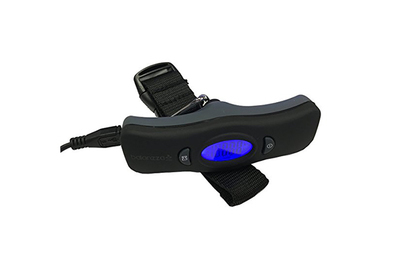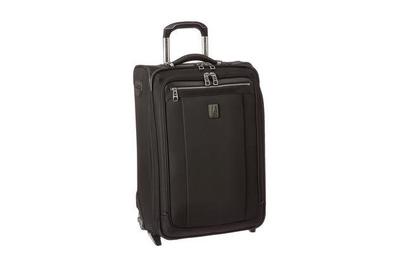How to Turn Your Existing Carry-On Into Smart Luggage
If you want a suitcase that weighs itself, tracks its location, and charges your phone, smart luggage is one option.1 But you don’t have to buy a new bag to get those features. For most people, it’s easier and more affordable to add them to a bag you already own and love. We’ve spent dozens of combined hours researching and reviewing the best Bluetooth trackers, luggage scales, and USB battery packs. We tested our picks in those categories against three of the most buzzworthy smart-luggage brands to determine the best way to make your existing carry-on a bit smarter.

As of this writing, I’ve tested four brands of smart luggage: Bluesmart, Raden, Away, and Barracuda. Among these, the Raden does the best job threading the needle between traditional carry-on and smart features. It’s a nicely constructed hard-shell suitcase in its own right and all the features work as you’d expect. The scale is particularly nice: Lifting your suitcase by the handle to see an accurate weight reading on your phone screen (available only for iOS as of this writing) feels as futuristic as a riding a hoverboard. But even the Raden lacks some basic amenities that you’d expect in a $300 suitcase, such as a suiter or garment folder for protecting clothes and keeping them wrinkle-free.
We understand the appeal of an off-the-shelf solution, but if you do the math, going the DIY route is a better value, and will in most cases, get you a better bag—especially if you already have a bag you use and like. The combined cost of all the gadgets featured below is less than half the cost of the Raden and when it comes time to recycle or upgrade any individual part, you don’t need to strip down your luggage or send it back to the manufacturer for maintenance.
This blog was originally published in October 2016 and our picks may have changed since then. Be sure to consult our full reviews for the latest buying advice.
Can charge two power-hungry devices simultaneously at top speed—most batteries this size throttle back when more than one device is plugged in. About the size of a portable hard drive, it can fill a midsize smartphone about four times.
Buying Options
May be out of stock
The battery on the Raden has a 7,800 mAh capacity (about two iPhone recharges) and is about 4¾ by 2¼ by 1 inches. If you look at our guide to the best USB battery packs, you’ll see that you can get much more capacity in a similar package for about $30 if you get the RAVPower 16750 mAh Portable Charger – 3rd Gen. It’s a portable-hard-drive-sized slab measuring about 5 by 3¼ by ⅞ inches and weighing 11 ounces. In our tests, it had 55.6 Wh (11.03 Ah) of energy available—not the highest in this general size but enough to completely charge a tablet with power to spare, or to charge most smartphones five times over. This is more than twice the capacity of the Raden’s built-in battery, about 65 percent more capacity than the Bluesmart, and it still fits neatly in the front pocket of the Travelpro Platinum Magna 2. If you need even more power, you can upgrade to the RAVPower 22000 mAh Ace Series Portable Charger.
Check out our full review for the latest buying advice for USB battery packs.
The Tile is the best proximity Bluetooth tracker for your luggage. With just under 2 million units sold, it’s backed up by the widest network of Bluetooth receivers available—making it more useful for tracking lost items.
Buying Options
After doing 20 hours of research and 30 hours of hands-on testing of the top contenders over the past two years, we found that no other tracker has the range or utility of the Tile Mate. It's our favorite Bluetooth tracker because it had one of the best ranges for maintaining a connection and reconnecting in our tests, and its alarm is louder and easier to hear than the alarms on other trackers. Tile also has the largest user base of its kind for its crowd-finding service, making it the most useful option for finding your luggage if your bag leaves your sight.
Putting a Tile in your bag lets you use the Tile app to see its current location (if it’s within Bluetooth range) or last known location (if you’re not close enough). So at the very least, you’ll be able to confirm where your bag isn’t. But if you mark an out-of-range Tile as lost, everyone else who has the app installed can “find” it for you (anonymously) if they come within range. You’ll get notified of its location, and they'll get a ping declaring that they helped a stranger find something. The situation sounds pretty hopeless, but Tile’s rising popularity means your odds of figuring out where your stuff is might be higher than you’d expect if your bag is somewhere in a busy airport. This system works nearly identically to Raden’s Bluetooth tracking, except Raden has far fewer users than Tile does. We also like that Tile plays a ringtone to alert you of your item's presence, whereas Raden simply says in the app if it’s “within reach.” The tone will likely not be that audible in a crowded baggage-claim area, but it is pretty shrill, so we wouldn’t count it out if you’re listening carefully.
Though it would be nice if you could have a reliable GPS/cellular-based tracking system that can notify you of your bag’s location regardless of where it is, we don’t feel comfortable recommending any at this time. If that’s a must-have feature for you, Bluesmart is your only option—it worked well in our testing, and the GPS support makes it more accurate than cell-tower tracking alone.
We also tested LugLoc’s cell-tower tracking system, which you can add as an option to the Barracuda case, but we weren’t sold on its value. It costs $70 for the device alone (included free with the Barracuda), and you’ll have to pay an additional monthly or annual subscription fee ($5 and $30, respectively, as of this writing), but we’d like to see more accuracy for those prices. Because LugLoc lacks GPS, it can only estimate your bag’s location to within a few city blocks based on cell-tower triangulation. That’s helpful for knowing if your luggage wound up in the wrong airport, but it isn't as useful for tracking down a stolen or lost bag on city streets. If that’s worth the cost for you, though, consider it. Like Tile, LugLoc offers built-in Bluetooth proximity tracking when you’re within range, but unlike Tile, it doesn’t have a crowdsourced lost-and-found network. Also, instead of listening for a tone, you open the LugLoc app and follow the strength of the signal toward the source, similar to how you might use a metal detector to find a lost ring on the beach.
Check out our full review for the latest buying advice on Bluetooth trackers.
USB charging and a backlit screen mean it’s ready to go wherever, whenever.
Buying Options
The only thing we can’t faithfully re-create in our smart-luggage kit is probably the most attractive feature of smart luggage: a scale built into the top handle. Our luggage-scale pick is the next best thing. Though it’s not as slick as a built-in model, it will be just as accurate and still has a Micro-USB rechargeable battery. And it’ll still work if your phone runs into Bluetooth issues.
Check out our guide to the best travel gear for the latest buying advice on luggage scales.
For most flyers, this 22-inch Travelpro offers the best balance of size, price, reliability, and durability, with high-end details.
Buying Options
If you don’t already have a suitcase you love, you should consider our top pick. Unlike any piece of smart luggage we tested, it has a built-in garment folder and its soft-sided frame is more malleable and easier to pack, and has greater packing capacity than the hard-sided frames of both the Raden and Bluesmart. Though we prefer two-wheeled designs and think the extra 190 cubic inches of internal storage (about the size of a rolled-up sweatshirt) offered in the standard version is worth the money, the Platinum Magna 2 is also available in a four-wheeled spinner configuration if you value upright handling over better wheel durability.
Check out our full review for the latest buying advice for carry-on bags.
Footnotes:
1. We’re not addressing the crowdfunded models that will follow you around like an obedient puppy or let you ride them around the airport like a whacked-out Steve McQueen on a diminutive Triumph until we have proof that they work. Jump back.
Mentioned above
- After 10 years of airport dashes and overhead-compartment stashes, the Travelpro Platinum Elite is still the suitcase we want to carry.The Best Carry-On Luggage
- If you’re worried about losing your stuff, a Bluetooth-enabled tracker can help. We have recommendations for iPhone and Android users.The Best Bluetooth Tracker
- Since 2014, we’ve spent more than 200 hours researching and testing dozens of products to find the most dependable items to help you travel well.The Best Gear for Travel
- Our power bank picks allow you to pack hours of extra battery life in a pocket or purse to charge a phone, tablet, or other small electronic device.The Best Portable Chargers and Power Banks for Phones and Tablets
Further reading
The Best Luggage Tags
by Geoffrey Morrison
We chose five luggage tags that will help you identify your belongings in a sea of similar suitcases.
The Best Folding Bike
by Amy Roberts and Duncan Niederlitz
After 85-plus hours of pedaling, shifting, folding, and unfolding, we’re convinced that the Dahon Mariner D8 is the best folding bike for most commuters.
The Best Travel Plug Adapter
by Geoffrey Morrison
We tested more than a dozen travel plug adapters to find the best to bring on a trip overseas. Nothing can cover you everywhere, but here are four good options.
We’ve Loved Luggage From Travelpro’s Platinum Elite Line for Nearly a Decade. Here’s Why.
by Kit Dillon
Travelpro Platinum Elite is our most loyal travel companion.







